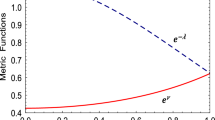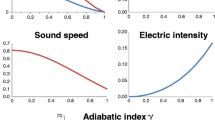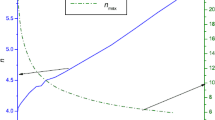Abstract
We present an anisotropic charged analogue of Heintzmann’s (Z. Phys. 228:489, 1969) solution of the general relativistic field equations in curvature coordinates by using simple form of electric intensity E and pressure anisotropy factor Δ that involve charge parameter K and anisotropy parameter α respectively. Our solution is well behaved in all respects for all values of X lying in the range 0<X≤1.1, α lying in the range 0≤α≤6.2, K lying in the range 0<K≤9.7 and Schwarzschild compactness parameter “u” lying in the range 0<u≤0.391. Since our solution is well behaved for a wide ranges of the parameters, we can model many different types of ultra-cold compact stars like quark stars and neutron stars. We present some models of super dense quark star and neutron stars corresponding to X=0.1, α=1 and K=3. By assuming surface density of quark star, ρ b =4.6888×1014 g cm−3 the mass and radius are 1.271M ⊙, 10.09 km respectively. For ρ b =2.7×1014 g cm−3 the mass and radius of neutron star are 1.675M ⊙, 13.297 km respectively. The well behaved class of relativistic stellar models obtained in this work might have astrophysical significance in the study of more realistic internal structure of compact stars.

Similar content being viewed by others
References
Bahcall, J.N., Wolf, R.A.: Phys. Rev. 140, B1452–B1466 (1965)
Baym, G., Chin, S.A.: Phys. Lett. B 62, 241–244 (1976)
Benvenuto, O.G., Horvath, J.E., Vucetich, H.: Int. J. Mod. Phys. 4, 257–265 (1989)
Bhattacharya, D., van den Heuvel, E.P.J.: Phys. Rep. 203(1–2), 1–124 (1991)
Bonnor, W.B.: Mon. Not. R. Astron. Soc. 137, 239 (1965)
Bowers, R.L., Liang, E.P.T.: Astrophys. J. 188, 657 (1974)
Delgaty, M.S.R., Lake, K.: Comput. Phys. Commun. 115, 395 (1998)
Dev, K., Gleiser, M.: Gen. Relativ. Gravit. 34(11), 1793–1818 (2002)
Dev, K., Gleiser, M.: Gen. Relativ. Gravit. 35(8), 1435–1457 (2003)
Dey, M., et al.: Phys. Lett. B 438, 123 (1998)
Doroba, W.: Acta Phys. Pol. B 20, 967–979 (1989)
Drago, A., Lavagno, A., Parenti, I.: arXiv:astro-ph/0512652 (2005)
Esculpi, M., et al.: Gen. Relativ. Gravit. 39, 633–652 (2007)
Ginzburg, V.L., Kirzhnits, D.A.: Zh. Èksp. Teor. Fiz. 47, 2006–2007 (1964)
Gleiser, M., Dev, K.: Int. J. Mod. Phys. D 13(07), 1389–1397 (2004)
Gold, T.: Nature 218, 731–732 (1968)
Gupta, Y.K., Maurya, S.K.: Astrophys. Space Sci. 332(1), 155–162 (2011)
Haensel, P., Schaeffer, R.: Nucl. Phys. A 381(5), 19 (1982)
Heintzmann, H.: Z. Phys. 228, 489 (1969)
Heiselberg, H., Pethick, C.J.: Phys. Rev. D 48, 2916–2928 (1993)
Horvath, J.E., Benvenuto, O.G.: Phys. Lett. B 213, 516–520 (1988). Institute of Physics Publishing, Bristol (1999)
Ivanov, B.V.: Phys. Rev. D 65, 104001 (2002)
Kaplan, D.B., Nelson, A.E.: Phys. Lett. B 175, 57–63 (1986)
Keister, B.D., Kisslinger, L.S.: Phys. Lett. B 64, 117 (1976)
Kippenhahn, R., Weigert, A.: Stellar Structure and Evolution. Springer, Berlin (1990)
Komathiraj, K., Maharaj, S.D.: Gen. Relativ. Gravit. 39, 2079 (2007)
Kuchowicz, B.: Acta Phys. Pol. B 2, 657 (1971a)
Kuchowicz, B.: Phys. Lett. A 35, 223 (1971b)
Kuchowicz, B.: Acta Phys. Pol. B 3, 209 (1972a)
Kuchowicz, B.: Phys. Lett. A 38, 369 (1972b)
Kuchowicz, B.: Acta Phys. Pol. B 4, 415 (1973)
Li, X.-D., et al.: Astron. Astrophys. 301, L1 (1995)
Mafa Takisa, P., Maharaj, S.D.: Gen. Relativ. Gravit. 45, 1951 (2013)
Maharaj, S.D., Mafa Takisa, P.: Gen. Relativ. Gravit. 44, 1419 (2012)
Malaver, M.: Gen. Relativ. Gravit. 39, 633–652 (2007)
Malaver, M.: Res. J. Model. Simul. 1(4), 65–71 (2014)
Maurya, S.K., Gupta, Y.K.: Astrophys. Space Sci. 332, 481–490 (2011)
Maurya, S.K., Gupta, Y.K.: Phys. Scr. 86, 025009 (2012)
Maurya, S.K., Gupta, Y.K.: Astrophys. Space Sci. 344, 243 (2013)
Migdal, A.B.: Nucl. Phys. 13, 655–674 (1959)
Migdal, A.B.: Zh. Eksp. Teor. Fiz. 61, 2209–2224 (1971)
Migdal, A.B.: Zh. Eksp. Teor. Fiz. 63, 1993–1999 (1972)
Olesen, M.L., Madsen, J.: Nucl. Phys. B 24, 170–174 (1991)
Olinto, A.V.: Phys. Lett. B 192, 71–75 (1987)
Olinto, A.: Nucl. Phys. B 24, 103–109 (1991)
Oppenheimer, J.R., Volkoff, G.M.: Phys. Rev. 55, 374 (1939)
Pacini, F.: Nature 219, 145–146 (1968)
Pant, N.: Astrophys. Space Sci. 240, 187 (1996)
Pant, N.: Astrophys. Space Sci. 338, 163 (2012)
Pant, D.N., Pant, N.: J. Math. Phys. 34, 2440 (1993)
Pant, D.N., Sah, A.: Phys. Rev. D 26(6), 1254 (1982)
Pant, N., Tewari, B.C., Fuloria, P.: J. Mod. Phys. 2, 1538–1543 (2011)
Pant, N., et al.: J. Gravity 380320, 9 (2014)
Ruderman, R.: Annu. Rev. Astron. Astrophys. 10, 427 (1972)
Sawyer, R.F.: Phys. Rev. Lett. 29, 382–385 (1972b)
Scalapino, D.J.: Phys. Rev. Lett. 29, 386–388 (1972)
Sokolov, A.I.: JETP Lett. 79, 1137 (1980)
Stephani, H., et al.: Exact Solutions of Einstein’s Field Equations, 2nd edn. Cambridge University Press, Cambridge (2003)
Sunzu, J.M., Maharaj, S.D., Ray, S.: Astrophys. Space Sci. (2014). doi:10.1007/s10509-014-1918-7
Thirukkanesh, S., Maharaj, S.D.: Class. Quantum Gravity 25, 235001 (2008)
Tolman, R.C.: Phys. Rev. 55, 364 (1939)
Usov, V.V.: Phys. Rev. D 70, 067301 (2004)
Weber, F.: Pulsars as Astrophysical Observatories for Nuclear and Particle Physics (1999)
Wolf, R.A.: Astrophys. J. 145, 834–841 (1966)
Wyman, M.: Phys. Rev. 75, 1930 (1949)
Author information
Authors and Affiliations
Corresponding author
Rights and permissions
About this article
Cite this article
Pradhan, N., Pant, N. Anisotropic charged analogue of Heintzmann’s solution. Astrophys Space Sci 356, 67–74 (2015). https://doi.org/10.1007/s10509-014-2198-y
Received:
Accepted:
Published:
Issue Date:
DOI: https://doi.org/10.1007/s10509-014-2198-y




